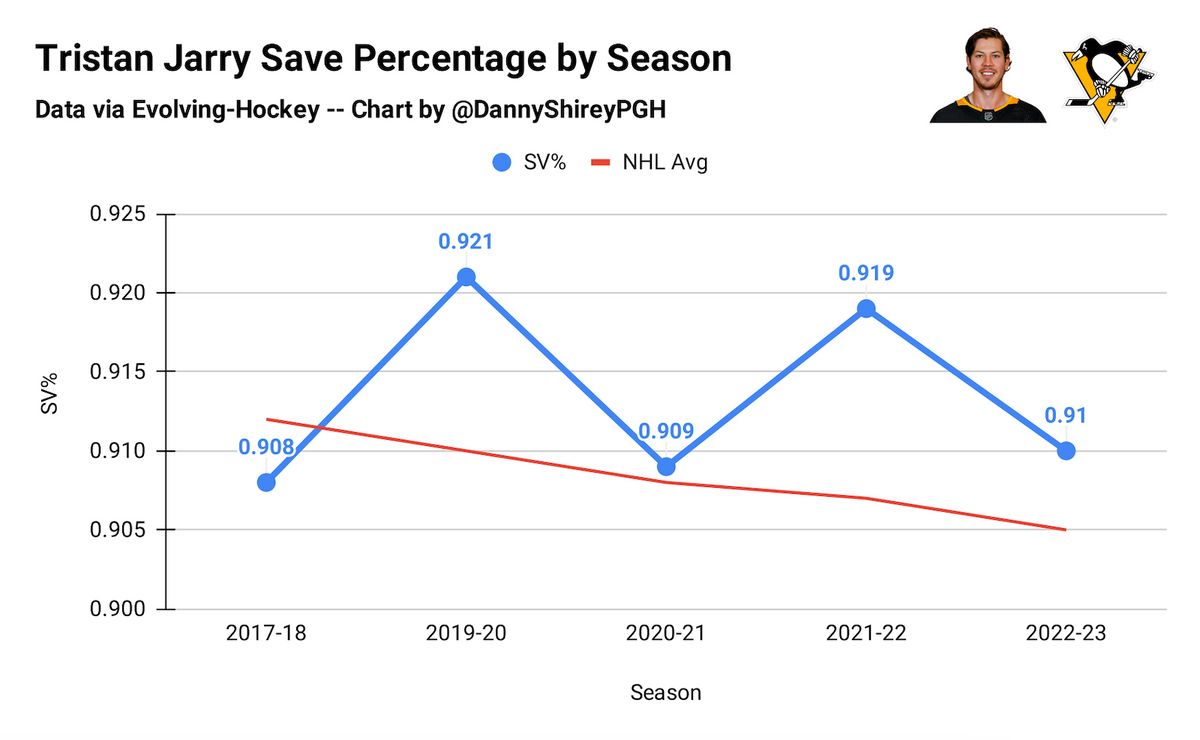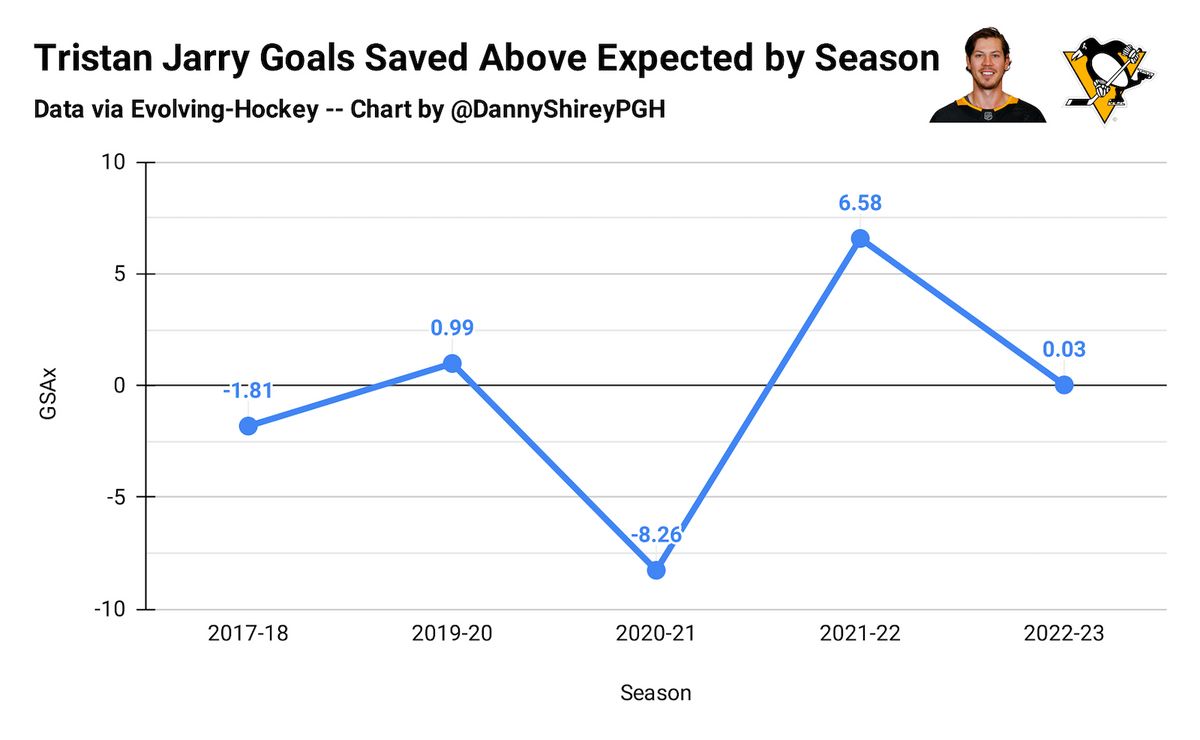There aren't many positions across professional sports that see greater volatility in performance than that of an NHL goaltender.
It's not uncommon in the slightest for goalies to follow up a relatively strong season with an immensely disappointing season, only to turn it around the season after that, reaching or exceeding their previous levels.
The inverse is true, as well. It seems as though there are a few goalies every season who come out of nowhere after everyone's written them off as the league's backup fodder.
There are plenty of contextual factors in play here that contribute to those swings, but it remains true that individual goaltending performance is incredibly inconsistent.
In a way, Tristan Jarry's NHL career embodies that to a T.
Jarry, turning 28 next month, will become an unrestricted free agent at the end of the season. The Penguins will have a pivotal decision to make on their future between the pipes, and it's not going to be an easy one.
He was enjoying a pretty nice season up until he was injured during the Winter Classic in Boston on Jan. 2. He was out for 18 days before returning, only to make two starts before missing nearly a month of action. His performance has been on a downward track ever since.
Despite Mike Sullivan and Jarry himself downplaying any lingering injury concerns, his movement in the crease -- both laterally and in the butterfly -- just doesn't seem quite right. It's a bizarre situation, because if Jarry really isn't dealing with the after effects of his injuries right now, it doesn't paint a great picture of his capabilities. If he is dealing with those effects ... well, that's just as big of a problem.
Jarry has made nine starts since his most recent return from injury on Feb. 20. In those nine starts, he's been pulled in favor of Casey DeSmith three times, he's posted a save percentage above .903 just three times, and he's alarmingly allowed four or more goals five times.
The Penguins aren't going anywhere without Jarry. But they aren't going anywhere with that Jarry, either.
His highs have earned him two All-Star appearances, yet his lows have brought legitimate concern over whether or not he's the guy.
Here's a look at his save percentage, by season, with a red line indicating that season's league average:

It's true that Jarry's raw save percentage has been comfortably above average each of the past two seasons, but it sticks out that every season has been a different tale for him.
Adjusting for his workload and the quality of looks he faced each season paints a nearly identical picture:

Coming into this season, Jarry really only had one campaign in which he performed considerably better than a league-average netminder would have facing the same workload. That was last season, in which he saved 6.5 goals above expected.
He's followed it up with a perfectly average season, though perfectly average ain't gonna cut it for these Penguins.
It goes without saying, but Jarry has yet to really prove himself when it's mattered most. His first postseason series as the team's No. 1 was one of the worst single-series performances of the stats era (since 2007-08), as he posted an .888 save percentage and allowed 6.8 goals more than expected in just six games.
The following postseason, he started just one game due to a broken foot.
Even a bullish outlook on Jarry's future performance must recognize that his availability is -- and has been -- a cause for concern.
The Penguins have played 218 games in the regular season and postseason since Jarry took over for Matt Murray as the team's starter in 2020-21. He's appeared in 140 of those games, or 64.2%.
A quick glance at a handful of other starters who have remained with the same team during that timeframe shows he's nowhere near elite company in that regard:
• Connor Hellebuyck has appeared in 79.4% of games for the Jets
• Andrei Vasilevskiy has appeared in 80.1% of games for the Lightning
• Juuse Saros has appeared in 74.6% of games for the Predators
• Sergei Bobrovsky has appeared in 64.2% of games for the Panthers
• Carter Hart has appeared in 58.5% of games for the Flyers
Now, the best of the best are inherently going to get more starts than those who are struggling, but it's also clear the best of the best are actually available to be utilized in that manner.
So, do the Penguins bring back Jarry, or do they let him walk?
If I was Ron Hextall, I wouldn't make up my mind one way or the other until seeing how the rest of the season plays out. The truth, though, is that it's an unenviable situation no matter what.
Let's say Jarry turns a corner -- starting Thursday night in New York against the Rangers -- and settles into a groove somewhere between where he was at earlier in the season and where he's been at the past month. Even if he goes on to perform adequately in the postseason and wins a series, does that really set aside any qualms regarding his inconsistencies from season-to-season?
And if that does indeed end up happening, it will obviously end up increasing the annual value of the next contract he signs. The Penguins would likely be locking themselves to Jarry at a pretty penny with considerable term, all while taking on a boatload of risk.
On the flip side, let's say Jarry stays healthy the rest of the way but continues to provide uninspiring results. At that point, I'd have to imagine his perceived value would take quite the hit from where it was back in December. There's the possibility he could be re-signed at a team-friendly rate with lesser term, but a boatload of risk would remain by committing to him as the No. 1.
This is kind of like being stuck between a rock and a hard place. 86 goalies will become free agents over the summer. With the exception of Jeremy Swayman (who will be a restricted free agent) and maybe Ilya Samsonov (based alone on the season he's having), I'm not convinced any of them would be tangible upgrades over Jarry, even if they are available more frequently.
It's starting to look more and more like the Penguins might not have a choice but to bring Jarry back. If the money's right, it might even make sense to do so, but again, it comes with significant risk. If not, they'd be wise to find their next starter via trade rather than signing someone on the open market.

